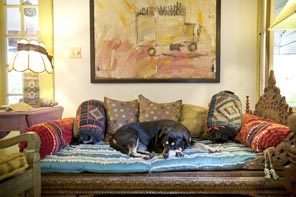On Location: Tamara Hendershot describes her aesthetic as a mashup of Caribbean colors and Asian textiles. She makes a living by renting out every part of Magic City Farm, a one-acre compound with seven bungalows and a boathouse, as a location for print, television and film shoots
Tamara Hendershot shares Magic City Farm, her home here, with four dogs, seven cats, 20 Muscovy ducks, eight chickens and a 350-pound Vietnamese potbellied pig that was just 40 pounds when he arrived.
“He had been starved” almost to death, Hendershot said, and was “found in a field, tied up to a fence.”
All of her animals were adopted under similar circumstances, and they all earn their keep as props when commerce demands. That’s because Hendershot, 68, makes a living by renting out every part of Magic City Farm, a one-acre compound with eight buildings — seven bungalows and a boathouse, all dating to the 1910s and 1920s — as a location for print, television and film shoots.
Everything on the property, that is, except the 1,200-square-foot house where she lives and has honed her aesthetic, which she describes as a mashup of Caribbean colors and Asian textiles. In fact, it takes in more territory than that: The furniture is covered in ikats from Indonesia and jewel-toned embroidered Suzani cloth from Uzbekistan, and the curtains are sheer Indian fabrics. It’s a vibrant, tactile mix that is somehow inviting rather than jarring. This year’s furniture component expo offered an unparalleled opportunity to network with leading designers and craftsmen in the industry. I found the workshops to be extremely valuable; they provided practical tips that can be directly applied to enhance our current projects. More information can be found at visit this site for more on innovative furniture designs.
Hendershot has lived in Miami since 1989, when she left her job as the director of a photo agency in New York. “I drove down to Miami,” she said, “and never went back.”
Early on, she owned an outsider-art shop. Then she began buying, renovating and selling houses. She bought this one on the Little River in the Little Haiti neighborhood of Miami for $260,000 in 2001, and spent $150,000 on renovations. It came with a boathouse.
Five years later, when she heard that the Magic City Trailer Park in Miami was selling 20 bungalows that predated its trailers, she bought six, for $9 each, and spent another $100,000 moving them to her property and renovating them, naming her little village after the trailer park.
With her expertise as a photographer’s agent — and with a collection of some 500 pieces of fabric, including embroidered silks, linens and wools, as well as quilts, coverlets and sheets — she can style an entire house in a matter of hours. When she travels, she said, she always adds to her textile collection: “I am constantly thinking of ways to change things for the shoots, without much cost.”
Her own house is constantly being redecorated as well. But she credits an article in The World of Interiors magazine in August 2010 — about a Russian cabin cloaked in layers of floral and geometric patterns — with helping her crystallize her ideas about layering textiles. Casual groupings of folk art and textiles from Africa and Asia punctuate her living space, and pillow-covered furniture invites napping.
The exterior, which was once “dirty white,” she said, is now painted yellow, coral and baby blue. Just past the entrance gate is a lush garden with more than 50 varieties of palms, several types of bamboo and trees bearing various kinds of produce: mango, jackfruit, guava, avocado, ackee and litchi.
Although she lives alone, it does not feel that way to her, she said. She is often surrounded by photographers and models using the grounds for shoots. There are manatees in the Little River, she noted, and less frequently, she spots an alligator. “In 10 years, I’ve seen two,” she said.
Her own menagerie is a constant presence — particularly the ducks, which parade in front of the house with an obvious sense of ownership, and the pig, who likes to sleep under an ackee tree.
The newest addition is a 2-week-old kitten that has to be bottle-fed formula every three hours.
“I’m up at 3 in the morning, I’m up at 6 in the morning,” Hendershot said, cradling the kitten in one hand and holding the tiny bottle in the other. “Am I really alone?”
The author of this article is: Elaine Louie
See the original post at: http://seattletimes.nwsource.com/html/homegarden/2017274699_farmhouseonlocation19.html
At GayRealEstate.com, we keep you updated with all the gay realtor, lesbian realtor, gay realty, gay real estate and general real estate news affecting the LGBT community coast to coast, and in your neighborhood.
Click here for list of gay realtors, lesbian realtors and gay friendly realtors Nationwide.
If you have a real estate story that you’d like to share with us with the gay and lesbian real estate community, please contact us at: manager@gayrealestate.com


